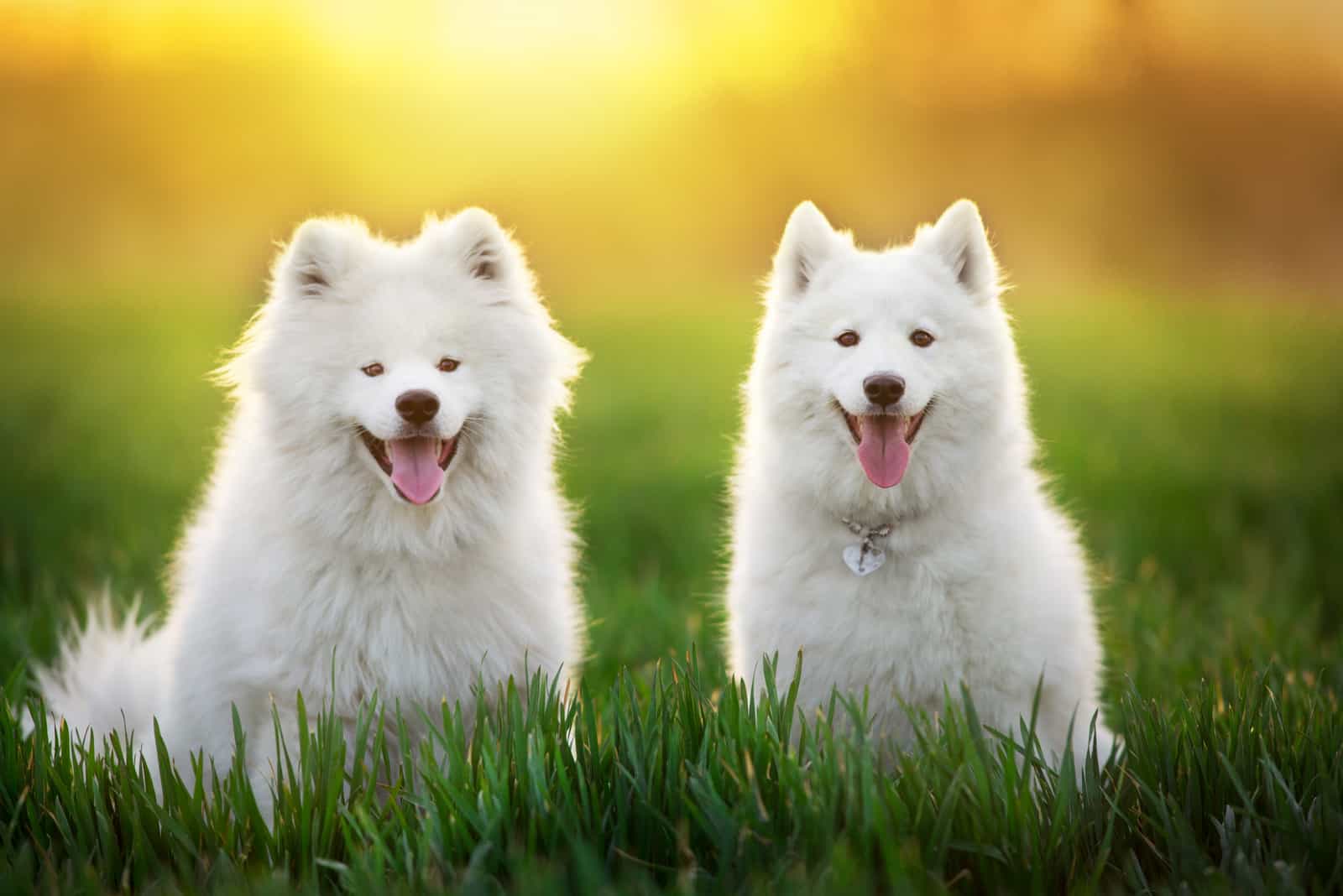The Samoyed dog takes its name from the Samoyedic peoples of Siberia. These nomadic reindeer herders bred the fluffy, white, smiling dogs and used them to pull their sleds, guard their property, and herd reindeer. The dogs even slept with the people to keep them warm as they have a profuse double coat, with a longer outer coat of harsh hair and a soft, thick, wooly undercoat.
Robert Scott, an explorer, brought the dogs to England in 1889. It was in England that the breed was further developed, and from there, it spread throughout the rest of the world. It was recognized by the American Kennel Club (AKC) in 1906.
The Samoyed is also known as the “Sammy smile” due to the slight, but discernible, upturned corners of its mouth. To this day, the Samoyed’s reputation as an intelligent, dignified, family dog is well deserved.
He often chooses to dote on one special person in the household, but he is affectionate with every family member. Happiest when he is part of family life, this dog breed needs to be with people. In fact, leaving a Samoyed alone too much is the best way to make him miserable.
The Samoyed is the best dog for families with small children that are looking for an intelligent, gentle, and loyal dog. So, if you are thinking of getting a new Samoyed puppy, one of the first things you may have considered is whether to get a male or a female Samoyed because there are some general rules of how each gender acts.
Apart from their anatomical differences, male and female Samoyeds are slightly different in looks, temperament, health, trainability, and how they interact with people and other dogs.
The main differences are that a male Samoyed is more playful, more likely to bond with all family members equally, and has more desire to please his owner, while the female Samoyed is slightly easier to train, less demanding of attention, and more cautious with children.
If you’re interested in finding out all the differences in the male vs female Samoyed breed, then read on.
Are Male Or Female Samoyeds Better?

This is one of the questions most people ask when they wonder about what gender of the dog they should get. A Samoyed’s gender is only one small aspect to consider when deciding to get one. There are plenty of other factors that will affect how your pet’s overall temperament, health, and behavior will be once they grow up.
Unless you have a specific reason for choosing one gender over the other, like, say, you want a female Samoyed for breeding purposes, then the gender of your dog shouldn’t be a huge factor in your decision.
However, depending on the situation, a specific gender Samoyed might be a better option. For example, if you have a Samoyed and you want another dog, a male Samoyed is friendlier around other dogs and pets than a female.
This article is here to give you a general overview of the traits of both genders. After all, you are the person who makes the decision as to which one you want; a male or a female. Whatever you decide, make sure you choose a pet that will fit your lifestyle and energy level.
Differences Between The Male and Female Samoyed
Male Vs. Female Samoyed differences can be seen in the following table:
[table id=44 /]
Samoyed Male Vs. Female Size
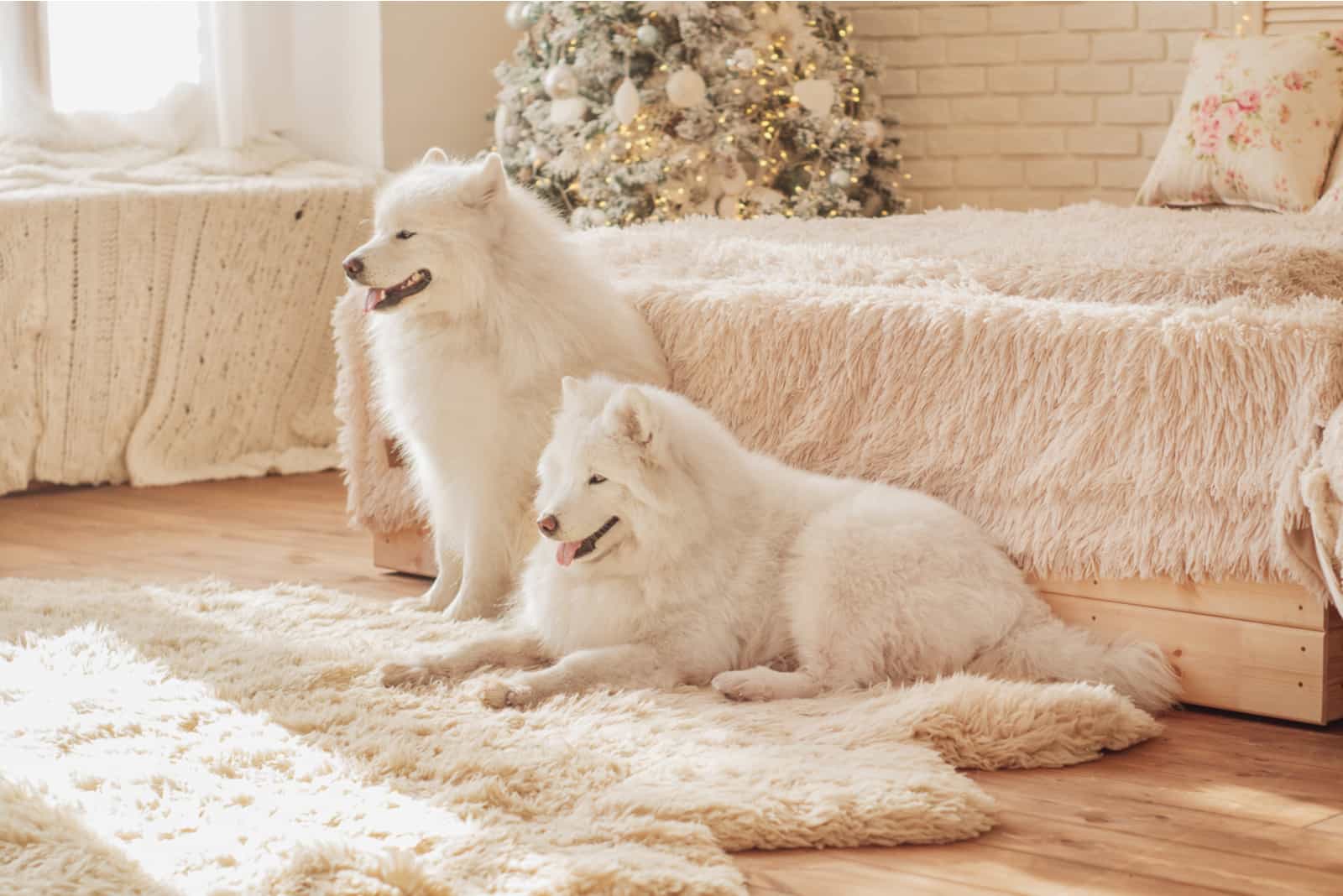
Fédération Cynologique Internationale has standards for all the dog breeds that are officially recognized. They also have a standard for the Samoyed, and this standard describes these dogs as medium-sized and elegant spitz-type dogs that appear to be powerful, have great endurance, charm, and are dignified and self-confident.
In terms of physical build, a male and female Samoyed look the same upon initial glance. But, if you look closer, slight differences can be seen in male vs. female Samoyed size.
A male Samoyed is bigger and heavier compared to a female. They stand between 21 and 23 inches in height, and can weigh between 45 and 65 pounds. They also tend to have a distinctive look. They have blockier, more masculine heads and sport a heavier ruff around their necks.
Female Samoyeds are smaller in build and bone structure. They stand at a height of 19 to 21 inches and weigh around 35 to 50 pounds. Their bodies are longer compared to males, and they feature a less prominent ruff on their necks.
Spaying A Female Samoyed
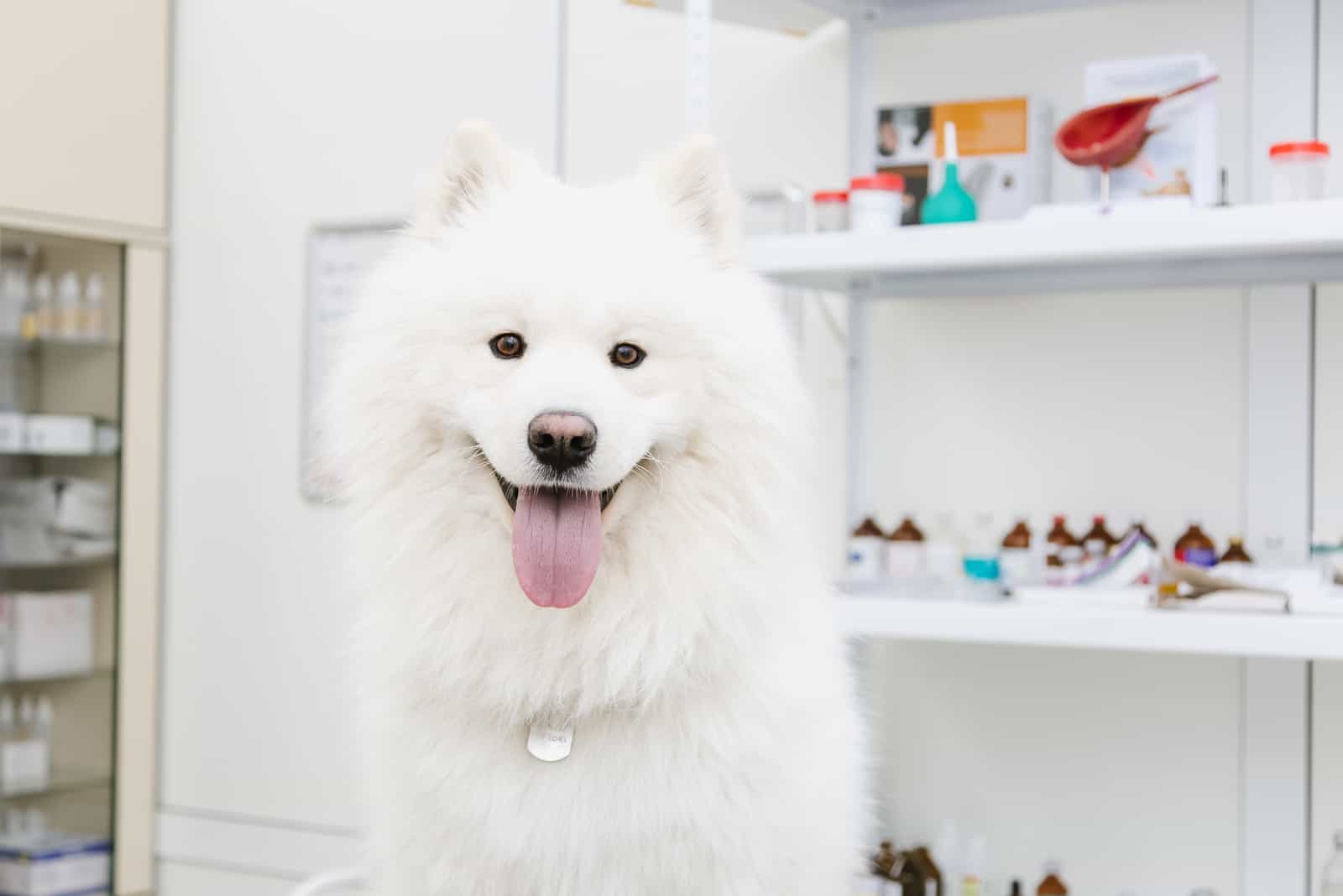
Even if your Samoyed is purebred and AKC registered, you do not have to breed him or her. Furthermore, do not breed your dog just to give your children a lesson in nature, nor because you believe that breeding your male dog or female dog makes them more fulfilled. Not only can you not control what happens, but it can be even more than you are able or willing to handle.
Most whelpings (the birth) take several hours, and seem to occur most often through the night. Young children and many adults find the birthing process rather unpleasant and very stressful. Even the most experienced are never sure that everything will go well and that they know what to do next.
It is a well-known fact that a female Samoyed goes into heat. For this period, you will notice a significantly hiked receptiveness (on the part of your dog) to sexual advances from male dogs.
The heat period of your Samoyed commonly runs for two weeks. A female Samoyed will experience its first heat cycle around five months while some could take as long as 10 months to go into their first heat.
Unless you plan on breeding your female Samoyed, it is recommended that you spay her. Spaying (ovariohysterectomy) is the surgical removal of the ovaries and uterus. This operation is a little complicated, but it is still considered routine, and in most cases, your pet is also home the next day… a little sore, but otherwise, showing few signs of distress.
Besides eliminating unplanned pregnancies, the operation eliminates the heat cycle. The heat cycle causes “cleanliness” problems for house dogs and the attraction of unwelcome neighborhood males with the cycles’ accompanying behaviors, odors, and discharges.
There is no correct answer as to when you should have your female dog spayed. Whilst some recommend spaying a female Samoyed before the first heat, others suggest that this can increase the risk of mammary tumors. You should consult your vet and ask for advice.
Neutering A Male Samoyed
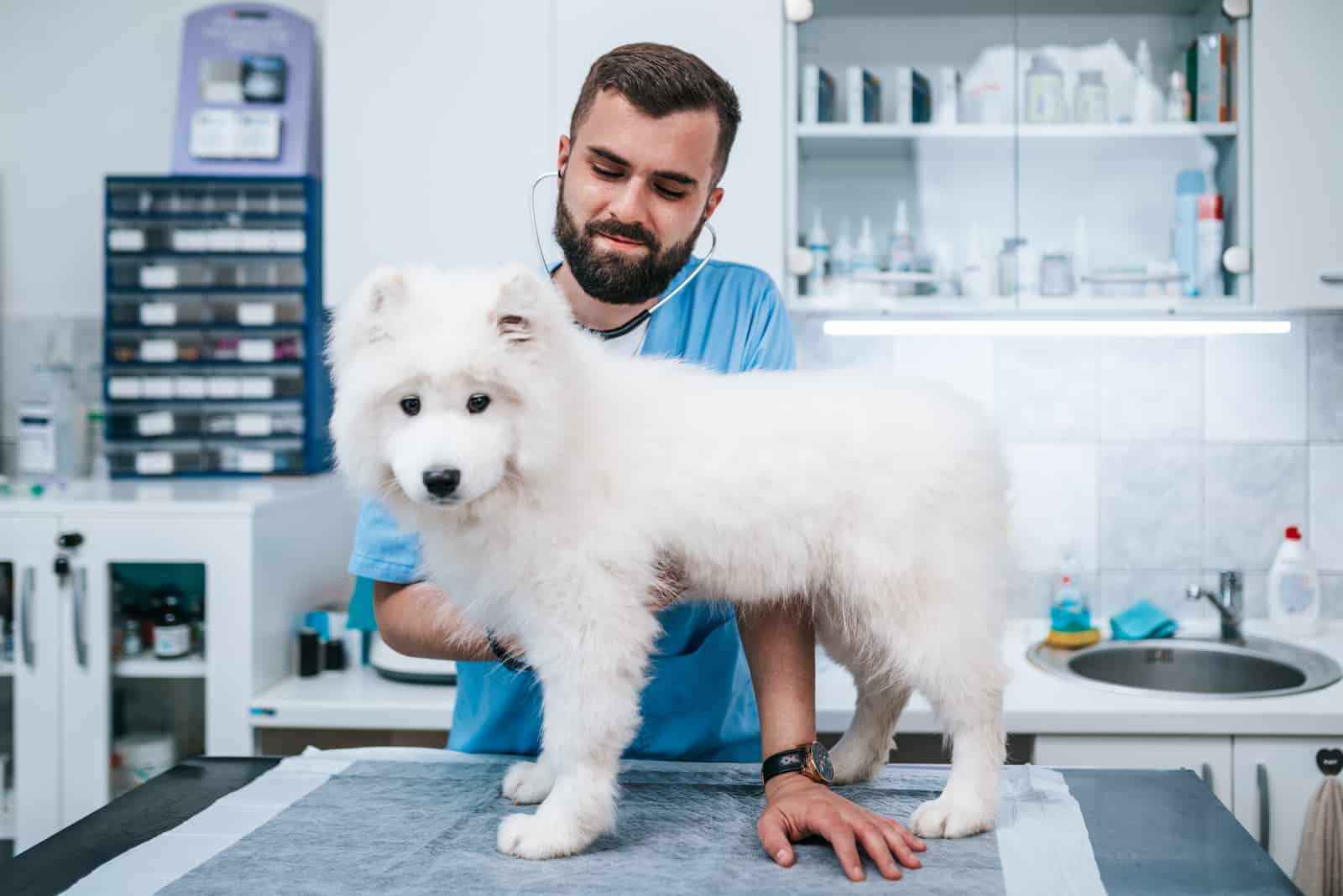
Often, people are mistaken into a moral argument if neutering your Samoyed is ethically right. Well, the truth is there is nothing cruel in neutering him. It is even crueler allowing unprotected Samoyed pups to spread across the place and end up in some animal shelter.
Neutering prevents aggressive and territorial behaviors, and it also means that your dog won’t be spending his entire walk hunting for a partner. With neutering, your vet removes not only the testicles, but also any associated structures.
The term also goes by castration. However, this is not the same as a vasectomy, in which a reproductive tube gets cut.
Neutering can reduce several common health problems:
• Adult males that have not been neutered, more so than neutered males, often develop prostatic complications and tumors of the reproductive tract.
• The neutering operation for males is relatively simple and the dog is usually back home the same or the following day with few ill effects. Behavioral changes can often be seen in as little as two weeks.
The good news is that the surgery is almost painless. Vets carry out neutering surgeries, adopting techniques as minimally invasive as they can get. Typically, your Samoyed would be anesthetized during the operation.
Reduce their activity in the days immediately following the surgery. They should not be running and jumping for at least 8 to 10 days. Make sure to examine the incision after the surgery.
Samoyed Temperament: Male Vs. Female
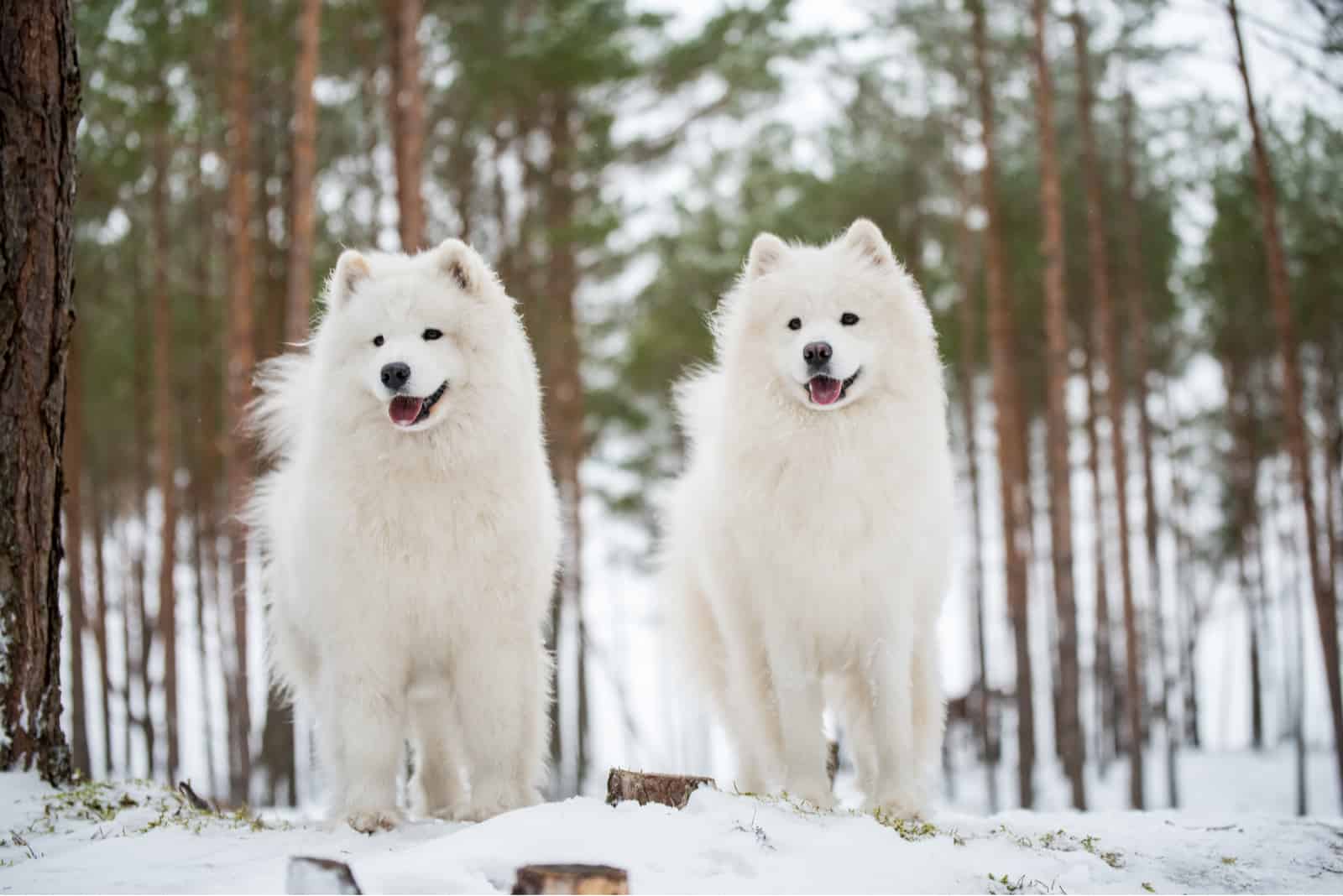
The majority of us are most often swayed by the looks of that adorable puppy with little or no regard for what that dog might eventually grow up to be as an adult. If the puppy is purebred, you have a reasonable expectation of what the adult dog will look like, but do you really have any idea what to anticipate in the way of temperament and behavior?
Unless you have thoroughly researched breed standards this can come as a rude and often unpleasant surprise, and it is frequently the reason why so many dogs wind up in a shelter after outgrowing that cute puppy stage.
A dog’s temperament is affected by a number of factors, including heredity, training, and socialization. Samoyed puppies with nice temperaments are curious and playful, willing to approach people and be held by them. The environment they live and grow up in will affect whether they will become aggressive or affectionate as an adult.
Generally, a dog’s gender doesn’t impact much of their behavior since their manners are acquired and shaped through training. But, there is one thing to note: Gender can affect the dog’s capacity to learn or adapt during training sessions.
The Male Samoyed
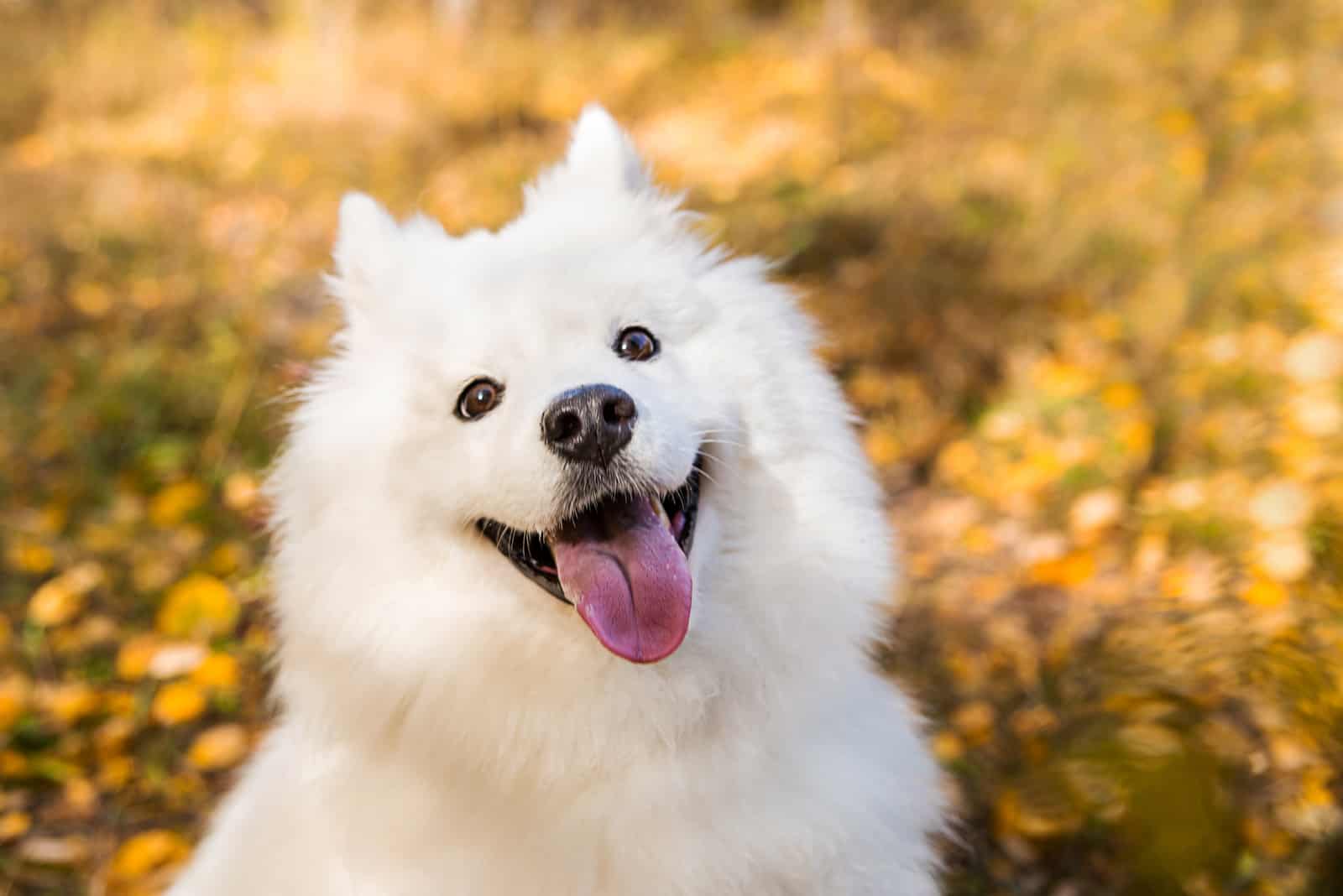
Male Samoyeds could get a bad rep because they are often accused of being more boisterous and dominant. But, this has more to do with their training and background than anything else.
They are friendly and affectionate with their family – they enjoy close association with those they live with, and are mentally and physically unsuited for being left alone in a kennel or a back yard. Their loyalty and alertness often make for good watchdogs.
Male Samoyeds are more stable with fewer emotional swings. They are more outgoing and welcoming when it comes to strangers and other pets. But, they can have a high prey drive. This means they will pounce on other tiny pets or animals in the form of play. Early socialization and training are important to prevent this kind of behavior.
Also, male Samoyeds are carefree, but more dependent compared to females. They can be mischievous and playful, with an extra ounce of energy to spare. This dog is already an active breed by nature, so this trait is important for dog owners to consider.
Male Samoyeds are a bit clumsy. They can bump or knock into objects around the home, and can run into their human owner without stopping. For this reason, they’re not recommended around small children since they could cause accidental injury. They are also more cuddly with their owners and even a bit clingy.
And, most importantly, they are fiercely loyal to their humans.
The Female Samoyed
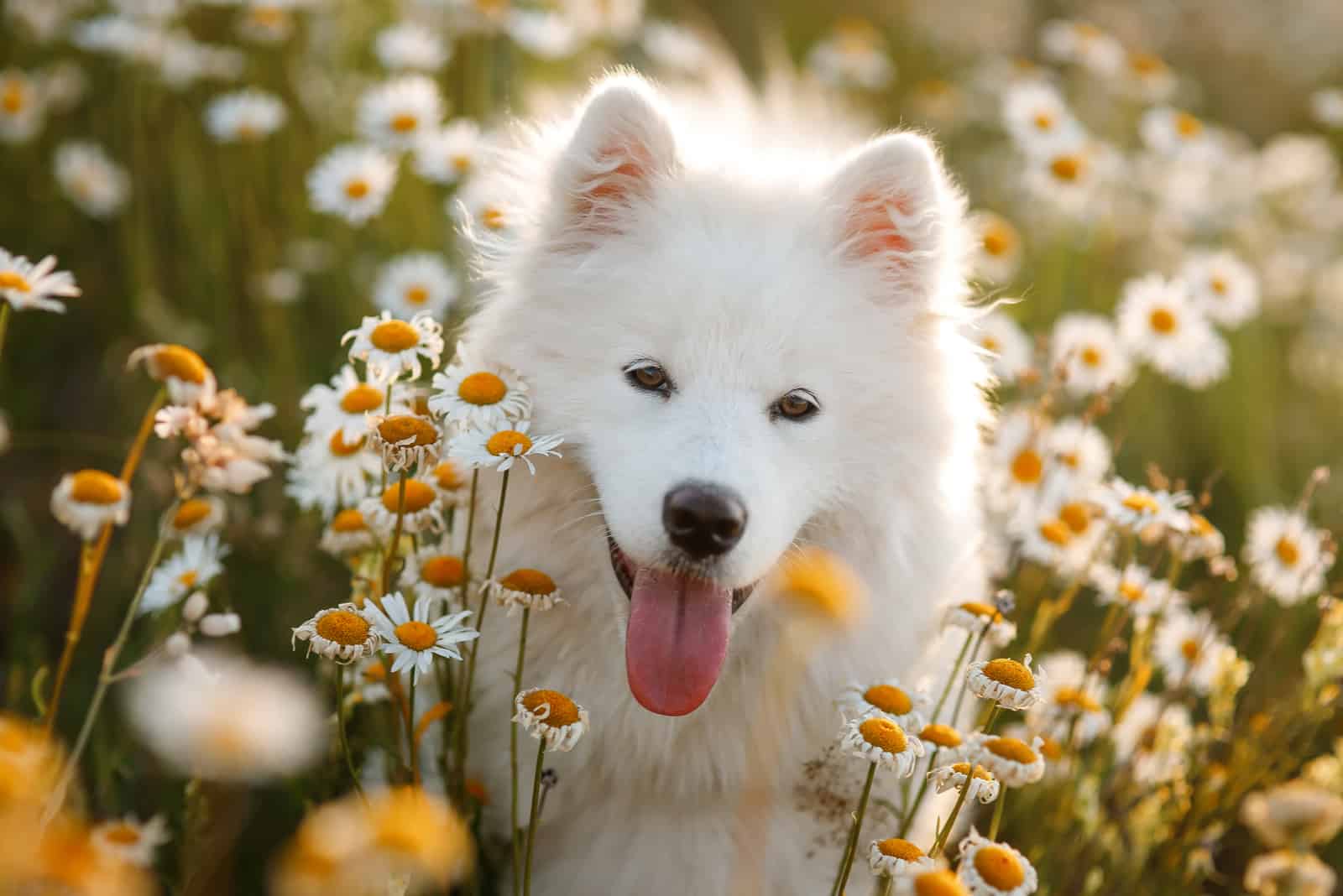
Female Samoyeds mature faster than males, even if the two are the same age. As a result, some owners prefer female Samoyeds because they’ll be easier to train. However, this doesn’t mean that they are smarter.
Females are also more affectionate, but this comes with a caveat; they are only affectionate whenever they want to be. For example, they can approach you to be petted, but they will walk away once they’ve had enough.
Female Samoyeds are less dependent and more self-sufficient. They are adorable, just like male Samoyeds, but they sometimes can be a little standoffish and moody. They are easier to housebreak because of their faster maturity level.
Unlike male Samoyeds, females are less social and a bit guarded when around strangers or other pets. They can get along with fellow female dogs outside the home, but they can become aggressive when a new female is brought in to live with them. However, a spayed female Samoyed can be less irritable and aggressive.
Female Samoyeds are also loyal to their humans.
Trainability Differences

The best time to start training your Samoyed is when he/she is a puppy. Social training, obedience training, and potty training are proven to be more successful when initiated in their early puppyhood years.
Socially training your Samoyed puppy will allow you to learn what triggers them and what calms them, so that they can play nicely with other animals and humans. Early obedience training is crucial for providing your Samoyed pup with a jump start towards developing good listening ears and following instructions correctly as soon as you give them.
They will see it as a form of leadership and security, and will become used to your actions as they grow. Potty training is always easier to start when they are puppies because they are more prone to take directions better and see it as bonding time between you and them.
Samoyeds generally want to please a fair and consistent owner, and they generally are very trainable with voice commands. Harsh training methods are usually not necessary with a properly bred Samoyed.
The arctic breeds such as the Malamute, the Siberian Husky, and the Samoyed are easily bored with repetitive dog training techniques. Training these breeds presents difficulties not encountered with the more tractable breeds like Labradors, Golden Retrievers, and German Shepherds.
Samoyeds are used to having lots of activities and tasks to complete, and are typically busy dogs. This breed is highly active and independent, and they will get bored when they don’t get enough stimulation or exercise. Boredom could lead to destructive behavior like chewing on your furniture.
Regardless of their gender, every Samoyed can develop bad habits when not trained right. For a male Samoyed, training can be challenging only because they mature much later and are easily distracted, making it difficult for them to focus on the commands you give out.
Housebreaking them will also be tricky for this reason. Because of this, some Samoyed owners prefer to wait until after the dog has turned four months old to start training it. Nevertheless, once you do find the right way to teach and train them, they are highly obedient animals.
Female Samoyeds are more focused and easier to train than males. With good reinforcement and patience, they can grasp what you’re trying to teach them in a short time. Females can be potty trained at a younger age than four months.
Male Vs Female Samoyed – Socialization

Like every dog, the Samoyed needs early socialization — exposure to many different people, sights, sounds, and experiences when they’re young. Socialization helps ensure that your Samoyed puppy grows up to be a well-rounded dog.
As mentioned above, male Samoyeds are usually more friendly towards other people than females. But, females are more affectionate. They get along well with smaller animals if they were raised together. When it comes to other dogs, this dog is usually friendly with them. Naturally, between two dogs of the same sex, there can be some tension.
Although these dogs are usually friendly and polite to strangers, they are also good watchdogs. If there is something or someone suspicious near their family or home, they will alert the family with loud barks. A Samoyed’s hunting instincts are strong, so the dog will probably seize every opportunity to chase smaller animals.
To be sure that your dog is exposed to many different situations, invite people to your house regularly, take your dog to the dog park regularly, and allow other dogs and other animals to get close to him so he can get used to many different situations, which will result in a well behaved dog.
Male Vs Female Samoyed: Health Issues

Samoyeds are generally healthy, but like all breeds, they’re prone to certain health problems. Not all Samoyeds will get any or all of these diseases, but it’s important to be aware of them if you’re considering this breed.
If you’re buying a new dog, find a good breeder who will show you health clearances for both your puppy’s parents. Health clearances prove that a dog has been tested for and cleared of a particular condition.
The Samoyed should do well on high-quality dog food, whether commercially manufactured or home-prepared, with your veterinarian’s supervision and approval. If you properly feed your dog, he/she will generally be in good health.
There are some genetic or inherited health problems and risks for Samoyeds. The most common are:
• Hip dysplasia
• Progressive Retinal Atrophy
• Glaucoma
• Samoyed Hereditary Ghlomerulopathy
• Diabetes Mellitus
Hip dysplasia – With hip dysplasia, the balls and sockets of the hind legs don’t fit one another properly. The main symptom of this disease is discomfort in the hind legs, such as stiffness and lameness.
Luckily, it can be treated easily with corticosteroids or anti-inflammatories. Dogs with hip dysplasia can also be given dog food that is nutritionally supplemented.
Progressive Retinal Atrophy – This is an eye disease that involves the gradual deterioration of the retina. Early in the disease, affected dogs become night-blind; they lose sight during the day as the disease progresses.
Glaucoma – This is defined by increased pressure in the eye, and can be found in two forms: primary, which is hereditary, and secondary, which is caused by decreased fluid in the eye due to other eye diseases. Symptoms include vision loss and pain, and treatment and prognosis vary depending on the type. Glaucoma is treated either surgically or with eye drops.
Samoyed Hereditary Ghlomerulopathy – This is a genetic disease of the kidney. The condition is more severe in males that appear healthy for the first three months of life until symptoms appear. Death from renal failure usually occurs by 15 months of age. Females develop mild symptoms at two to three months of age, but do not suffer renal failure.
Diabetes Mellitus – This is a disorder in which the body cannot regulate blood sugar levels. Diabetes can be controlled by diet and the administration of insulin.
Should I Get A Male Or A Female Samoyed?

Photo from: @mango.thesamoyed
Before you buy a new dog, there are a few important things to consider that can help you determine the best possible gender for you.
If a Samoyed is raised with another dog or other pets, they should get along fine with them. But, when it comes to introducing new dogs and pets to them, there is a chance that they might react differently based on their gender.
Male Samoyeds are friendlier around other dogs and pets than females. Also, male Samoyeds are ideal for you if you want a dog that’s friendly and has tons of energy, or if you want him to help you with herding or hunting. You don’t mind a high-maintenance animal? Choose a male Samoyed.
Female Samoyeds would be ideal for you if you have small children at home because females, while still active, are more cautious. This gender is excellent for you if you don’t mind grooming your animal daily or if you don’t mind lots of barking or vocalization.
Are you looking for a dog who can play with, exercise, or go out with you for an outdoor activity? Female Samoyeds are an excellent choice.
After considering all the differences between a male and a female Samoyed, it should be easier to pick which gender to go for. Still, gender isn’t the most important thing when it comes to what makes a good pet – training, socialization, and adequate care are.
Read Next: Japanese Spitz Vs. Samoyed – Which Is The Best Dog For You?


